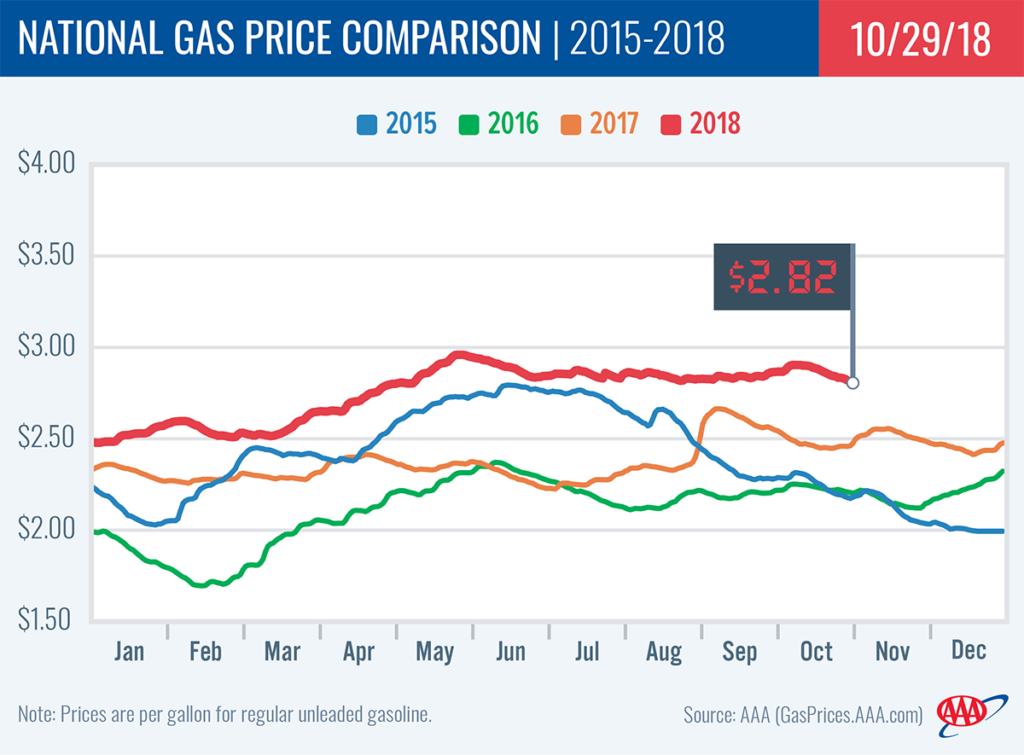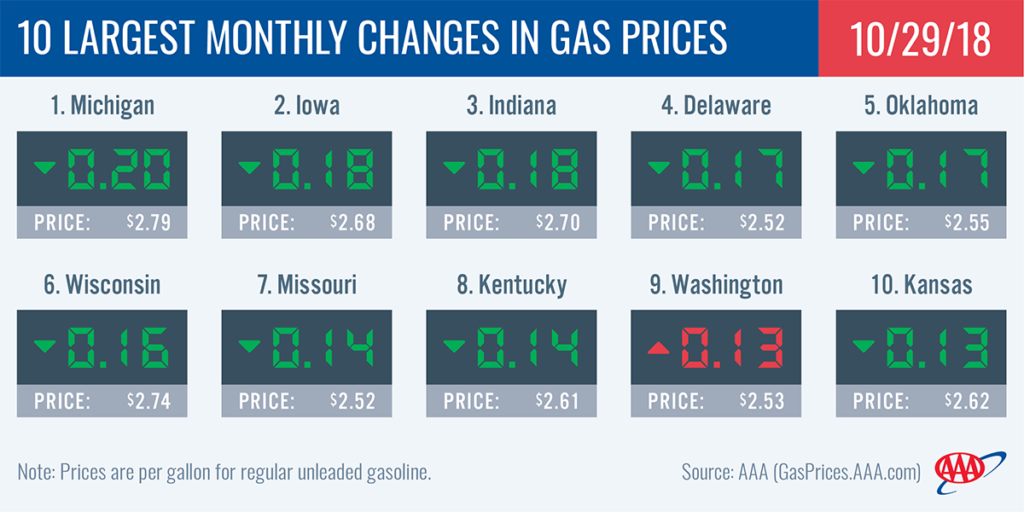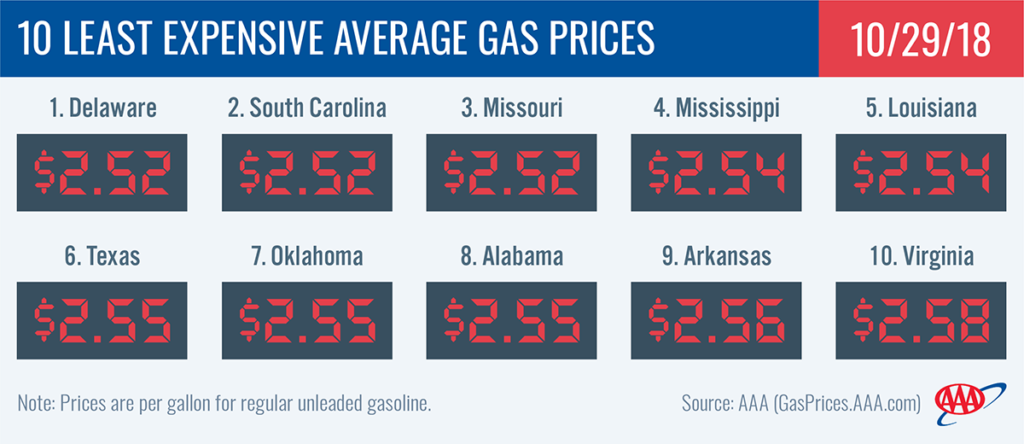The national gas price average has been dropping slowly and steadily for the past 16-days. At $2.82, the national gas price average is the lowest since mid-September, but the cheaper gas prices may just be a temporary treat for motorists.
“Just like the outside temperature, motorists are seeing gas prices cool off. The last few weeks saw peak refinery maintenance season start to wrap-up and push less expensive gas prices, but the lower prices are not likely to be a long-term trend,” said Jeanette Casselano, AAA spokesperson. “AAA expects that gas prices will likely start to increase as early as later this week ahead of the Nov. 5 Iran sanctions announcement and the mid-term elections.”
How expensive gas prices will be depends on how the market reacts to the early November events. However, motorists are not likely to pay summer prices this winter.
Today’s average is three cents less than last week, six cents cheaper than last month and 35- cents more expensive than this time last year.
Quick Stats
The Nation’s Largest Monthly Changes are: Michigan $2.79 (-20 cents), Iowa $2.68 (-18 cents), Indiana $2.70 (-18 cents), Delaware $2.52 (-17 cents), Oklahoma $2.55 (-17 cents), Wisconsin $2.74 (-16 cents), Missouri $2.52 (-14 cents), Kentucky $2.61 (-14 cents), Washington $2.53 (+13 cents) and Kansas $2.62 (-13 cents).
The Nation’s Top Ten Least Expensive Markets are: Delaware ($2.52), South Carolina ($2.52), Missouri ($2.52), Mississippi ($$2.54), Louisiana ($2.54), Texas ($2.55), Oklahoma ($2.55), Alabama ($2.55), Arkansas ($2.56) and Virginia ($2.58).
West Coast
Pump prices in the West Coast region are among the highest in the nation with six of the region’s states landing on the nation’s top 10 most expensive list. Hawaii ($3.90) is the nation’s most expensive market, followed by California ($3.80), Washington ($3.53), Alaska ($3.38), Oregon ($3.36), Nevada ($3.29), and Arizona ($2.91). On the week, all the prices in the region except for Hawaii are lower.
The Energy Information Administration’s (EIA) weekly petroleum status report for the week ending on October 19, showed West Coast gasoline stocks fell to 27 million bbl. Stocks are approximately 1.7 million bbl lower than at this time last year, which could cause prices to spike if there is a supply challenge in the region this week.
Great Lakes and Central
Except in Ohio (+8 cents) and Michigan (+3 cents), state gas price averages in the Great Lakes and Central region continue downward. This week, Iowa (-8 cents) saw the largest drop in the country and the region. With a six-cent decrease each, Missouri, Nebraska and Kentucky join Iowa as a top 10 state with the largest change on the week. The pump prices in Ohio and Michigan are atypical of the nationwide-trend this week and likely due to the general fluctuations seen in this region from time-to-time.
Gas prices are pushing cheaper as regional refinery utilization rates are climbing, signaling refinery maintenance season is starting to wrap-up and gasoline stocks could build. However, the region’s large draw of 1.9 million bbl could mean prices may jump early on this week. At 49.8 million bbl in total, stocks sit at their lowest level in 54-weeks. While low, the region typically sees stocks at this or lower levels around year-end, according to EIA data.
Mid-Atlantic and Northeast
As pump prices continue to drop, motorists in Pennsylvania ($2.99), Connecticut ($2.99), Washington, D.C. ($2.97) and New York ($2.96) are paying some of the cheapest prices to fill-up since May. These four states were consistently at the $3.00 or more mark the majority of the summertime.
On the week, four states saw the largest declines in gas price averages in the Mid-Atlantic and Northeast region: Maryland (-6 cents), Virginia (-5 cents), Maine (-5 cents) and Tennessee (-5 cents). Today, Delaware ($2.52) carries the cheapest gas in the region and country.
The region saw the largest draw in gasoline stocks of any region with a 2.3 million bbl drop. Some of the draw can be attributed to exports. Despite the decline, levels are relatively strong at 67 million bbl total. In fact, that is a nearly 11 million bbl surplus year-over-year.
South and Southeast
With a six-cent drop, six states saw the largest gas price average decreases in the South and Southeast on the week: Oklahoma, Texas, Louisiana, Georgia, Florida and South Carolina. All other states saw prices drop by as much as four-cents.
Seven of the top 10 cheapest gas prices in the country reside among states in the South and Southeast region this week. At $2.52, South Carolina has the least expensive gas price average in the region and is tied with Delaware for cheapest gas in the country.
Gasoline stocks hover near the 78 million bbl mark and only saw a 258,000 bbl draw this past week. This level is on par with this time last year.
Rockies
Idaho (+2 cents) and Utah (+2 cents) are among only four states in the country to see gas prices increase on the week. Meanwhile, Colorado (-3 cents), Wyoming (-2 cents) and Montana (-2 cents) saw prices decline since last Monday.
Compared to a year ago, state gas price averages in the Rockies region are at least 41-cents more expensive. The five Rockies region states rank as the seventh through eleventh states, respectively, with the largest year-over-year average increase in the country: Utah (+49 cents), Idaho (+45 cents), Colorado (+42 cents) Wyoming (+41 cents) and Montana (+41 cents).
With an increase of 300,000 bbl, the Rockies was the only region in the country to see gasoline stocks build on the week. At nearly 7 million bbl, stocks are on par with this time last year.
Oil market dynamics
At the close of Friday’s formal trading session on the NYMEX, WTI increased 26 cents to settle at $67.59. Crude prices ended last week with mostly losses, following release of EIA’s weekly petroleum report that showed crude inventories increased for the fifth consecutive week. Domestic crude inventories gained 6.3 million bbl to total 422.8 million bbl – a level not seen since the beginning of the driving season in June, according to EIA’s latest data. If this week’s EIA report shows another substantial build in total crude inventories, prices are likely to face more downward pressure. However, the potential price decline is likely to be short-lived, as U.S-imposed sanctions on Iran’s crude exports will take effect on November 5, which may heighten fears in the market about reduced global supply amid growing global crude demand.
Motorists can find current gas prices along their route with the free AAA Mobile app for iPhone, iPad and Android. The app can also be used to map a route, find discounts, book a hotel and access AAA roadside assistance. Learn more at AAA.com/mobile.



